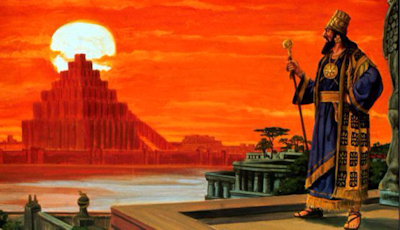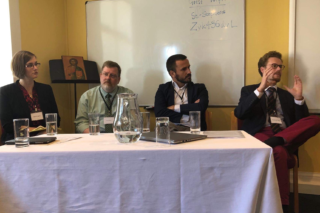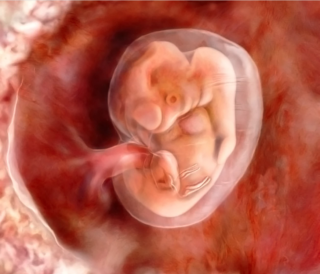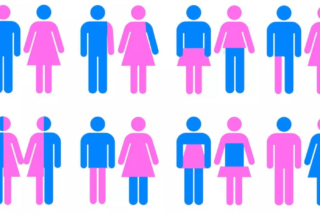As a theologian I often struggle with ways to translate conversation in the academy into useful materials for the church. What follows is a sermon that I preached in May 2008 when the Revised Common Lectionary presented the challenge of the Genesis creation narrative. I created a PowerPoint presentation to display as I spoke. Many of the images are presented here with the text.
It seems to me that until we can broach the subjects of authorship, composition, and context (ideas in biblical studies for 200 years) that we will continue to do a disservice to parishioners who look to the pastor to shed light on the meaning of texts. While examining this passage, I wanted to plant seeds for further discussions around gender and sexuality, creationism and science, and a desire to learn more about the formation of the Bible. I leave it to the reader to decide whether it worked...
 Today's lectionary reading presents us with the first creation narrative in Genesis. We've all heard this story before, though most likely in combination with the second creation account where God shapes Adam from the dust of the earth and then Eve from Adam's side. But today we'll focus on just the first narrative which ends in Genesis chapter two at verse four. Now for some of you I suspect the idea of two creation stories standing back to back in Genesis is a new one. If you're like me, you were probably raised hearing the two narratives creatively blended together, ignoring their contradictions, and smoothing out the rough spots to create one continuous account. If that's where you're coming from, I invite you to look at the story with me again in a new light.
Today's lectionary reading presents us with the first creation narrative in Genesis. We've all heard this story before, though most likely in combination with the second creation account where God shapes Adam from the dust of the earth and then Eve from Adam's side. But today we'll focus on just the first narrative which ends in Genesis chapter two at verse four. Now for some of you I suspect the idea of two creation stories standing back to back in Genesis is a new one. If you're like me, you were probably raised hearing the two narratives creatively blended together, ignoring their contradictions, and smoothing out the rough spots to create one continuous account. If that's where you're coming from, I invite you to look at the story with me again in a new light.
 To set the stage for our Genesis passage, I invite you on a journey through space and time. We'll be traveling back some 2500 years, give or take, to Babylon, the capital city of the Babylonian Empire, situated in what is now modern day Iraq. At that time, in the land between the Tigris and Euphrates rivers, we find a powerful, ancient city with a ziggurat that extended up into the sky. Bab-ilu, or "the gate of god" was home of the Babylonian god Marduk, whose military conquests were sung in temple services every New Year as the people remembered the story of how their world was created. It was here that the people of Jerusalem and surrounding Judah found themselves after the Babylonians destroyed their Temple and exiled their people in 598 and 587 BCE.
To set the stage for our Genesis passage, I invite you on a journey through space and time. We'll be traveling back some 2500 years, give or take, to Babylon, the capital city of the Babylonian Empire, situated in what is now modern day Iraq. At that time, in the land between the Tigris and Euphrates rivers, we find a powerful, ancient city with a ziggurat that extended up into the sky. Bab-ilu, or "the gate of god" was home of the Babylonian god Marduk, whose military conquests were sung in temple services every New Year as the people remembered the story of how their world was created. It was here that the people of Jerusalem and surrounding Judah found themselves after the Babylonians destroyed their Temple and exiled their people in 598 and 587 BCE.
"By the rivers of Babylon—we sat down and we wept when we remembered Zion. On the willows we hung up our harps. For there our captors asked us for songs, and our tormentors asked for mirth, saying, 'Sing us one of the songs of Zion!' How could we sing the Lord’s song in a foreign land?" (Psalm 137:1-4)
 The Psalmist tells how the Children of Israel mourned in captivity, far from home, in a land of military conquerors whose great god had successfully destroyed Jerusalem's defenses and brought the Kingdom of Judah to its knees.
The Psalmist tells how the Children of Israel mourned in captivity, far from home, in a land of military conquerors whose great god had successfully destroyed Jerusalem's defenses and brought the Kingdom of Judah to its knees.
For more than 400 years a series of kings had ruled in Jerusalem, until at last, King Nebuchadnezzar of Babylon besieged their city until it fell. King Zedekiah watched with horror as his sons were killed before him. Then the Babylonians gouged out his eyes, placed him in shackles, and carried him off into exile in Babylon.
 The Babylonians were known for their military might. And under Nebuchadnezzar, they pursued a policy of imperial expansion that swept from Egypt to the Caspian Sea. Nebuchadnezzar claimed a grant of universal kingship from Marduk to whom he prayed that he would have "no opponent from horizon to sky" (Brit). While in exile under this military superpower, the Jewish people grappled with questions about their own God who it seemed had abandoned them. They thought about how they'd leaned on their military might. They came to terms with their pride and their false sense of security.
The Babylonians were known for their military might. And under Nebuchadnezzar, they pursued a policy of imperial expansion that swept from Egypt to the Caspian Sea. Nebuchadnezzar claimed a grant of universal kingship from Marduk to whom he prayed that he would have "no opponent from horizon to sky" (Brit). While in exile under this military superpower, the Jewish people grappled with questions about their own God who it seemed had abandoned them. They thought about how they'd leaned on their military might. They came to terms with their pride and their false sense of security.
 But why start here? What's so important about Babylon? And how does it figure into the creation story of Genesis chapter one? I'd like to suggest that here, in this down and out place, the Jewish people came face to face with questions about the narratives they would choose to shape their worldview. Here, in the Exile, they would choose whether to embrace Marduk, the supreme deity of Babylon. Here, in the Exile, they would decide who their God was. They would decide who they were. They would decide how they would live.
But why start here? What's so important about Babylon? And how does it figure into the creation story of Genesis chapter one? I'd like to suggest that here, in this down and out place, the Jewish people came face to face with questions about the narratives they would choose to shape their worldview. Here, in the Exile, they would choose whether to embrace Marduk, the supreme deity of Babylon. Here, in the Exile, they would decide who their God was. They would decide who they were. They would decide how they would live.
The Babylonian creation story begins:
When skies above were not yet named
Nor earth below pronounced by name,
Apsu, the first one, their begetter
And maker Tiamat, who bore them all,
Had mixed their waters together,
But had not formed pastures, nor discovered reed-beds;When yet no gods were manifest,
Nor names pronounced, nor destinies decreed
Then gods were born within them.
Lahmu and Lahamu emerged, their names pronounced.
As soon as they matured, were fully formed,
Anshar and Kishar were born, surpassing them.
The names sound strange to us, so let's look at what they mean. In the beginning, Fresh Water and Salt Water were the first god and goddess. When they joined, they produced a god and a goddess of Silt, which in turn gave birth to the god Heaven and the goddess Earth. These in turn gave birth to Sky. Sky births Air. Air births a son, Marduk.
 At this point, a great battle erupts in which Marduk slays the ancient Father and Mother. From mother Tiamat's body he fashions the dome of heaven. Marduk gives marching orders to the other gods, setting Moon, Sun, and Stars in the sky and placing the Land and the Waters. Finally, Marduk kills one of the gods that rebelled against him. And from his blood he creates humans to be slaves to the gods.
At this point, a great battle erupts in which Marduk slays the ancient Father and Mother. From mother Tiamat's body he fashions the dome of heaven. Marduk gives marching orders to the other gods, setting Moon, Sun, and Stars in the sky and placing the Land and the Waters. Finally, Marduk kills one of the gods that rebelled against him. And from his blood he creates humans to be slaves to the gods.
Marduk is declared king of all of the gods and commands that Babylon be built with a ziggurat that reaches to the heavens. And then a great chorus arises:
"At the mention of his name we shall bow down!
[Gods] pay heed to what he says:
His command is […]priority above and below.
The son who avenged us shall be the highest!
His rule shall have priority; let him have no rival!
…Let him designate the black-headed people to revere him,
That mankind may be mindful of him, and name his as their god" (Dalley 264).
Against this backdrop, the Genesis creation narrative arises. Faced with utter defeat at Jerusalem and Exile in Babylon. Faced with the awesome force of Nebuchadnezzar and his armies. Faced with Marduk, who rises up and kills his forebears, ordering the gods of sun, moon, stars, earth and sea to take their places. Marduk, who creates human beings from the blood of an executed rebel. Marduk who built mighty Babylon. Marduk who is embodied in the person of Nebuchadnezzar, king over all the Babylonian Empire.
Against this backdrop the priests of the Jewish Temple were inspired to write down a new narrative:
 a subversive narrative, a narrative that would stand in quiet but bold opposition to this savage Marduk and the gods over whom he reigned – a narrative that would defy the dominant story of the Babylonians and their might; a narrative in which humans are not slaves, but instead are created in the very image of God.
a subversive narrative, a narrative that would stand in quiet but bold opposition to this savage Marduk and the gods over whom he reigned – a narrative that would defy the dominant story of the Babylonians and their might; a narrative in which humans are not slaves, but instead are created in the very image of God.
"In the beginning when God created the heavens and the earth, the earth was a formless void and darkness covered the face of the deep, while a wind from God swept over the face of the waters" (Genesis 1:1-2).
Here we find no dragon Tiamat, no Fresh Water and Salt Water gods. There's no mating ritual which brings forth the Silt, or Sky, or Land. Instead, we find God Elohim, whose very word brings order out of chaos. Tiamat the dragon is replaced by the Hebrew tehom, the watery void.
 "'Let there be a dome in the midst of the waters, and let it separate the waters from the waters.' So God made the dome and separated the waters that were under the dome from the waters that were above the dome. And it was so" (Genesis 1:6b-7).
"'Let there be a dome in the midst of the waters, and let it separate the waters from the waters.' So God made the dome and separated the waters that were under the dome from the waters that were above the dome. And it was so" (Genesis 1:6b-7).
Tiamat's dead body is replaced by a dome, like a hammered metal bowl turned upside down. And within this dome, a pocket is formed, filled with air allowing animals to breathe. Above the sky, the blue waters can still be seen, held at bay by the dome. Openings in the dome allow water above the sky to pour through as rain.
"'Let the waters under the sky be gathered together into one place, and let the dry land appear.' And it was so." (Genesis 1:9b).
Instead of gods of Earth and Water the Jewish priests described raw elements of the same name. It is God Elohim, who orders the chaos, making dry land. Over the next several verses God will cause plants to grow, and place the sun, moon and stars in the dome to provide light for day and night and seasons for the whole creation. The Babylonian gods are replaced by inanimate, created objects, under the control of God Elohim.
Bugs, herds, creeping things. God proceeds to fill the creation with animal life. But here, the most daring, the most subversive revision of the Babylonian tale is revealed:
"Then God said, 'Let us make humankind in our image, according to our likeness…'
"So God created humankind in his image, in the image of God he created them; male and female he created them…" (Genesis 1:26a, 27).
In Babylon, Marduk was supreme. Marduk was king. Marduk was the great god, before whom every knee should bow. And Nebuchadnezzar, king of Babylon, ruled in Marduk's stead. Only the king could claim to be made in the image of his god. Against this backdrop, the inspired Jewish priests made their boldest claim: God Elohim created humankind in his own image, both male and female. Let Nebuchadnezzar declare his greatness. But the Jewish people would celebrate this: all people are created in God's image. Not just kings, not just priests, not just men… both men and women are created in God's image.
And so, as they returned from captivity in Babylon, a generation older and wiser, the Jewish people had a new narrative to shape their worldview. No longer would their faith be in their earthly king, or their military might. No longer would they trust in horses or chariots. Though their neighbors sang annual praises to a blood-thirsty god who slew his ancestors and created humans as slaves, the Jewish people would greet each New Year with a new narrative – a narrative in which God Elohim, spoke…
Spoke…
 And the creation came into order. While Marduk had raged and ordered the other gods into their places, God Elohim worked in quiet confidence, setting the elements of creation in place, creating a safe space for life, creating humanity to reflect his own image. And to this day, this narrative is read after the Jewish New Year in synagogues throughout the world. It is a narrative that says "no" to the destruction of Babylon. It is a narrative that says "no" to killing in order to create. It is a narrative that says "no" to the slavery of humanity at the hands of a blood-thirsty god.
And the creation came into order. While Marduk had raged and ordered the other gods into their places, God Elohim worked in quiet confidence, setting the elements of creation in place, creating a safe space for life, creating humanity to reflect his own image. And to this day, this narrative is read after the Jewish New Year in synagogues throughout the world. It is a narrative that says "no" to the destruction of Babylon. It is a narrative that says "no" to killing in order to create. It is a narrative that says "no" to the slavery of humanity at the hands of a blood-thirsty god.
To chaos it speaks comfort. To war it speaks peace. To subjugation and slavery it speaks rest. This is the narrative by which the Jewish people consciously chose to live their lives when they returned to Zion. And this is the narrative with which our Bibles begin.
But wait… Is that all? Is this where we leave the narrative? Is this what we have been called to?
Obviously, I wouldn't ask the question if I thought so…
Though this newer narrative is much better than Marduk's bloody feud, if we look at it closely, we find that it's not without its own causes for concern. True, God creates humans in his own image. True, both male and female are affirmed. So what could possibly be wrong with this story?
…
The answer lies in the very structure of the Hebrew language in which this creation narrative is written. Hebrew has only two genders: masculine and feminine. So every noun is one or the other. There is no exception.
 God Elohim turns out to be masculine. And from here all manner of problems arise. When God is depicted exclusively as an all-powerful male figure who rules over all, we plant the seed of patriarchy: the reasoned system of bias regarding gender which denotes prejudice in favor (privilege) of men and prejudice against women in matters of law, economics, politics, custom, ethics, religious life and commerce.
God Elohim turns out to be masculine. And from here all manner of problems arise. When God is depicted exclusively as an all-powerful male figure who rules over all, we plant the seed of patriarchy: the reasoned system of bias regarding gender which denotes prejudice in favor (privilege) of men and prejudice against women in matters of law, economics, politics, custom, ethics, religious life and commerce.
 Though Genesis 1 tells us that humanity is created in the image of God, throughout the history of the world it is primarily men that have held the positions of kings, priests, tribal leaders and heads of families. And though if asked, "Is God male or female?" most of us might reply "neither" or "both," this is an abstract understanding grasped only with maturity. Ask most any child if God is a "he" or a "she" and they'll tell you exactly who God is.
Though Genesis 1 tells us that humanity is created in the image of God, throughout the history of the world it is primarily men that have held the positions of kings, priests, tribal leaders and heads of families. And though if asked, "Is God male or female?" most of us might reply "neither" or "both," this is an abstract understanding grasped only with maturity. Ask most any child if God is a "he" or a "she" and they'll tell you exactly who God is.
There doesn't appear to be an easy answer for this one. If you've never given gender in language much thought, ask any trans person and I'm sure they can relate first-hand experiences of the shortcomings of gendered nouns and pronouns. Though there are a few languages in which there are non-gendered pronouns, English doesn't happen to be one of them.
The biblical authors appear to have also wrestled with this question. Perhaps their answers, coupled with the inspiration of the Holy Spirit, can provide us with some starting points. Though years of patriarchy have left us with a lopsided view of a masculine-only God, we still find passages in which God is a woman who carries Israel in her womb (Isaiah 42:14; 46:3) and gives birth.
God nurses her child and provides her child with comfort (Isaiah 49:15; 66:13). God is a midwife (Psalm 22:9), and provides food and water as women did in Old Testament times.

 God is also a mother eagle, bearing up Israel on her wings (Deuteronomy 32:11-12). God is a mother bear, protecting her cubs (Hosea 13:8) – an image that should have special appeal to certain parts of our own community.
God is also a mother eagle, bearing up Israel on her wings (Deuteronomy 32:11-12). God is a mother bear, protecting her cubs (Hosea 13:8) – an image that should have special appeal to certain parts of our own community.
And in the New Testament Jesus describes God as a woman who searches her house for a lost coin, not resting until all that is hers is accounted for (Luke 15:8-18).
And so, with these images in mind, I challenge us all to listen to the gentle breath of God (feminine in Hebrew, neuter in Greek) as it speaks to us – both now and in the days to come – bringing to our attention new ways in which we can share with others the full image and likeness of our God – both male and female.
Listen as the Spirit leads: To chaos may we speak comfort. To war may we speak peace. To subjugation and slavery may we speak rest. Amen.









